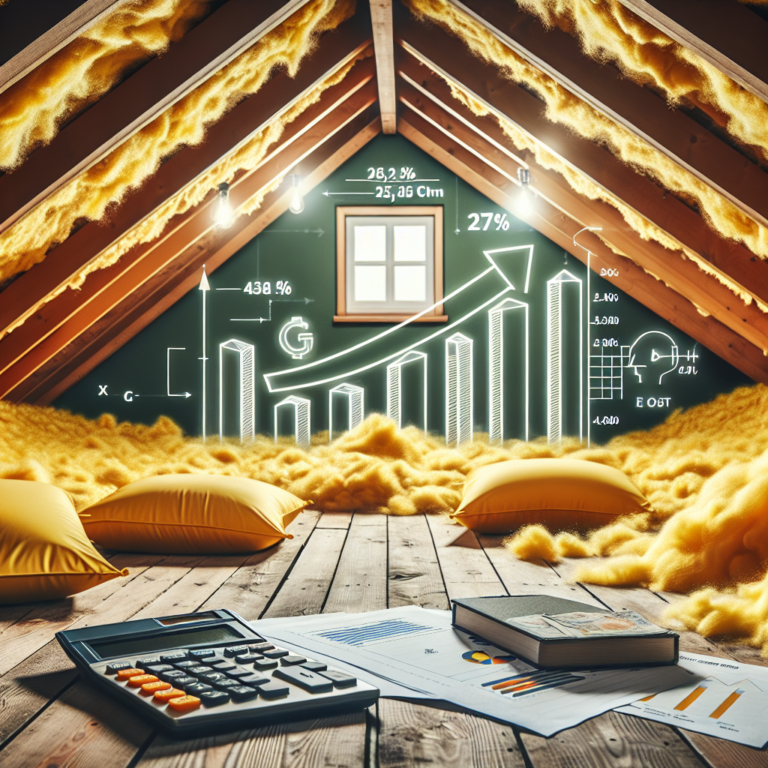-
Table of Contents
Insulate once, enjoy comfort for years – the longevity of blown-in insulation.
“Discover the longevity of blown-in insulation and all the essential information you need to know. Don’t miss out on the benefits of this insulation method. Visit texasinsulationsolution.com to learn more and schedule your installation today!”
Introduction
Blown-in insulation is a popular method of insulating homes and buildings, as it is cost-effective and efficient. However, many people wonder about the longevity of this type of insulation. In this article, we will discuss everything you need to know about how long blown-in insulation lasts and factors that can affect its lifespan. By understanding the lifespan of blown-in insulation, you can make informed decisions about your home’s insulation needs.
Benefits of Blown-In Insulation for Reducing Carbon Footprint
Blown-in insulation has become a popular choice for homeowners looking to reduce their carbon footprint and save on energy costs. This type of insulation is made from recycled materials, making it an environmentally friendly option. But how long does blown-in insulation actually last? In this article, we will explore the benefits of blown-in insulation for reducing carbon footprint and discuss its lifespan.
First and foremost, blown-in insulation is a great way to reduce your carbon footprint. This type of insulation is made from recycled materials such as shredded newspaper, cellulose, and fiberglass. By using recycled materials, blown-in insulation helps to reduce the amount of waste in landfills and decreases the need for new materials to be produced. This, in turn, reduces the carbon emissions associated with manufacturing new insulation materials.
In addition to its environmental benefits, blown-in insulation also has a long lifespan. On average, blown-in insulation can last up to 20-30 years. This is due to its dense and compact nature, which allows it to maintain its effectiveness over time. Unlike traditional insulation materials, blown-in insulation does not settle or compress, ensuring that it will continue to provide insulation for many years.
Furthermore, blown-in insulation is known for its energy-saving properties. By creating a barrier between the inside and outside of your home, it helps to regulate the temperature and reduce the need for heating and cooling. This, in turn, reduces the amount of energy needed to maintain a comfortable temperature, resulting in lower energy bills. With blown-in insulation, you can save up to 20% on your energy costs, making it a cost-effective and eco-friendly choice.
Another benefit of blown-in insulation is its ability to reduce noise pollution. The dense and compact nature of this insulation helps to absorb sound, making it an excellent choice for homes located in noisy areas. This can be especially beneficial for those living near busy roads or airports. By reducing noise pollution, blown-in insulation not only creates a more peaceful living environment but also contributes to a healthier ecosystem by minimizing noise disturbance for wildlife.
Moreover, blown-in insulation is a versatile option that can be used in various areas of your home. It can be installed in walls, attics, and even floors. This makes it a great choice for both new constructions and existing homes. Additionally, blown-in insulation can be easily installed in hard-to-reach areas, ensuring that every nook and cranny of your home is properly insulated.
When it comes to the lifespan of blown-in insulation, proper installation is key. It is essential to hire a professional to install the insulation to ensure that it is evenly distributed and properly sealed. This will not only maximize its effectiveness but also extend its lifespan. It is also important to regularly inspect and maintain the insulation to ensure that it is still in good condition.
In conclusion, blown-in insulation is an excellent choice for reducing your carbon footprint and saving on energy costs. Its long lifespan, energy-saving properties, and versatility make it a popular option for homeowners. By choosing blown-in insulation, you are not only making a sustainable choice for your home but also contributing to a healthier environment for future generations. So, if you are looking to reduce your carbon footprint and save on energy costs, consider blown-in insulation as a viable option for your home.
Factors That Affect the Lifespan of Blown-In Insulation
Blown-in insulation is a popular choice for homeowners looking to improve the energy efficiency of their homes. It is a cost-effective and efficient way to insulate attics, walls, and other areas of the house. However, like any other home improvement project, it is important to consider the lifespan of blown-in insulation before making a decision. In this article, we will discuss the factors that can affect the lifespan of blown-in insulation and what you need to know to ensure its longevity.
One of the main factors that can affect the lifespan of blown-in insulation is the type of material used. There are various types of blown-in insulation available in the market, such as cellulose, fiberglass, and mineral wool. Each type has its own unique properties and can last for different lengths of time. For example, cellulose insulation is made from recycled paper and has a lifespan of around 20-30 years, while fiberglass insulation can last for up to 50 years. Mineral wool, on the other hand, has a lifespan of 100 years or more. Therefore, it is important to consider the type of material used when determining the lifespan of blown-in insulation.
Another factor that can affect the lifespan of blown-in insulation is the installation process. Improper installation can lead to gaps and voids in the insulation, which can reduce its effectiveness and shorten its lifespan. It is crucial to hire a professional and experienced contractor to install blown-in insulation to ensure that it is done correctly. A well-installed insulation can last for decades, while a poorly installed one may need to be replaced much sooner.
The location of the insulation also plays a significant role in its lifespan. Blown-in insulation in areas with high moisture levels, such as basements and crawl spaces, may be prone to mold and mildew growth. This can not only reduce the effectiveness of the insulation but also lead to health hazards. To prevent this, it is important to properly seal and ventilate these areas before installing blown-in insulation. Additionally, insulation in areas with high foot traffic, such as attics, may get compressed over time, reducing its effectiveness. Regularly checking and fluffing the insulation can help maintain its effectiveness and prolong its lifespan.
The climate and weather conditions of the area where the insulation is installed can also affect its lifespan. In areas with extreme temperatures, such as very hot summers or harsh winters, the insulation may experience wear and tear at a faster rate. This can lead to a decrease in its effectiveness and may require replacement sooner. It is important to choose the right type of insulation for your climate to ensure its longevity.
Regular maintenance and upkeep can also play a crucial role in the lifespan of blown-in insulation. Over time, insulation may settle and become compact, reducing its effectiveness. It is recommended to have a professional inspect and fluff the insulation every few years to maintain its effectiveness. Additionally, keeping the area around the insulation clean and free from debris can also help prolong its lifespan.
In conclusion, the lifespan of blown-in insulation can vary depending on various factors such as the type of material used, installation process, location, climate, and maintenance. It is important to consider these factors before choosing blown-in insulation for your home. By selecting the right type of insulation, hiring a professional contractor, and regularly maintaining it, you can ensure that your blown-in insulation lasts for many years, providing you with energy efficiency and comfort in your home.
Tips for Maintaining Energy Efficiency with Blown-In Insulation
Blown-in insulation has become a popular choice for homeowners looking to improve their energy efficiency. This type of insulation is made up of small particles, typically made of fiberglass, cellulose, or mineral wool, that are blown into the walls, attic, or other spaces in a home. It is known for its ability to fill in small gaps and crevices, providing a more complete coverage than traditional batt insulation. However, like any other home improvement, it is important to understand the lifespan of blown-in insulation and how to maintain its effectiveness.
The lifespan of blown-in insulation can vary depending on several factors. The type of material used, the installation process, and the climate in which it is installed can all impact its longevity. On average, blown-in insulation can last anywhere from 20 to 30 years. This is a significant lifespan compared to other types of insulation, making it a worthwhile investment for homeowners.
One of the key factors in determining the lifespan of blown-in insulation is the type of material used. Fiberglass insulation, which is made up of tiny glass fibers, is known for its durability and can last up to 30 years. Cellulose insulation, made from recycled paper products, has a slightly shorter lifespan of around 20 years. Mineral wool, which is made from natural rock or slag, can last up to 50 years. It is important to consider the material used when choosing blown-in insulation, as it can have a significant impact on its longevity.
Another important factor to consider is the installation process. Blown-in insulation must be installed properly in order to be effective and have a longer lifespan. This includes ensuring that the particles are evenly distributed and that there are no gaps or voids in the insulation. Improper installation can lead to settling, which can reduce the effectiveness of the insulation and shorten its lifespan. It is important to hire a professional installer who has experience with blown-in insulation to ensure it is installed correctly.
The climate in which the insulation is installed can also impact its lifespan. Blown-in insulation is designed to withstand extreme temperatures and moisture, but certain climates can be more challenging than others. For example, areas with high humidity or frequent temperature fluctuations may cause the insulation to settle or become compressed over time. This can reduce its effectiveness and shorten its lifespan. It is important to consider the climate of your area when choosing blown-in insulation and to regularly check for any signs of settling or compression.
To maintain the energy efficiency of blown-in insulation, there are a few tips that homeowners can follow. Regularly inspecting the insulation for any signs of settling or compression is important. If any issues are found, it is important to address them promptly to prevent further damage. Additionally, keeping the insulation dry is crucial. Moisture can reduce the effectiveness of the insulation and lead to mold or mildew growth. Proper ventilation and addressing any leaks or water damage in the home can help prevent moisture from affecting the insulation.
In conclusion, blown-in insulation can last anywhere from 20 to 30 years, depending on the type of material used, the installation process, and the climate in which it is installed. It is important to choose a reputable installer and regularly inspect the insulation for any signs of settling or compression. By following these tips, homeowners can maintain the energy efficiency of their home and get the most out of their blown-in insulation for years to come.
Q&A
1) What is blown-in insulation?
Blown-in insulation is a type of insulation material that is installed by blowing it into the desired space using specialized equipment. It is typically made of materials such as fiberglass, cellulose, or mineral wool.
2) How long does blown-in insulation last?
The lifespan of blown-in insulation can vary depending on the type of material used and the conditions it is exposed to. On average, blown-in insulation can last anywhere from 20-30 years.
3) What factors can affect the lifespan of blown-in insulation?
Some factors that can affect the lifespan of blown-in insulation include moisture, pests, and settling. Moisture can cause the insulation to lose its effectiveness, while pests can damage or displace the material. Settling can also occur over time, reducing the insulation’s thickness and effectiveness. Proper installation and regular maintenance can help extend the lifespan of blown-in insulation.
Conclusion
In conclusion, blown-in insulation can last for several decades if properly installed and maintained. However, its lifespan can vary depending on factors such as the type of insulation material used, the quality of installation, and the environmental conditions. It is important to regularly inspect and maintain blown-in insulation to ensure its effectiveness and longevity. With proper care, blown-in insulation can provide long-lasting energy efficiency and comfort for your home.




